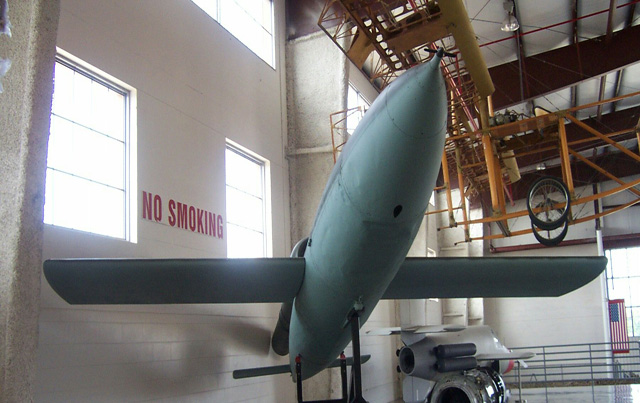
1944 Fieseler V-1 Buzz Bomb
Designed by the Germans during World War II, this pilot-less aircraft carried nearly a ton of explosives and was used to bomb London and southeast England.
Eight-thousand, six hundred V-1s were launched from the northern shores of occupied France over a period of two months in 1944. At a preset distance, the fuel was shut off and the V-1 dove into the ground. Many were destroyed by anti-aircraft fire and fast flying British Meteor jet aircraft, but more than 2000 fell on London. After the invasion of France, the Allies overran the launch sites and the V-1 did not continue to pose much of a threat, although some were still launched from He-111 bombers.
During initial testing, many V-1s crashed, and it was not known why the gyro-stabilizing system would not maintain controlled level flight. The decision was made to make a piloted version in an attempt to solve the problem. Legend has it that famous German female pilot Hanna Reitsch test flew the aircraft. When the speed increased to a certain point, it was found that the wooden wings were twisting beyond what the gyro could control. Because of her observations, the wings were stiffened and the problem was solved. Toward the end of the war, piloted suicide versions of this concept were considered.
Specifications
- Year Built — 1944
- Wingspan — 18’7″
- Speed — 360 mph
- Gross Weight — 6,614 lbs
- Engine — Argus As 014 pulse jet (530 lbs thrust)
Kermit’s Comments
The V-1 used a pulse jet engine for thrust, mounted above and at the rear of the main body. This very simple design incorporates moveable shutters in the front of the engine and a tuned exhaust tube in the rear. Fuel is introduced behind the shutters in a chamber and ignited with a spark plug. The resulting explosion causes the shutters to close and the expanding gases are forced out the rear. As the expanding gases escape, the tuned exhaust tube eventually creates a negative pressure in the chamber. Fuel is again introduced into the chamber and the process is repeated, giving it a very distinctive WHOOM – WHOOM – WHOOM sound. Once the engine was started, the air source was removed. When the engine was brought up to full speed thrust, the V-1 would be released and accelerate up a long launch ramp on rails that would allow it to gain enough speed to create the lift needed to continue its flight.